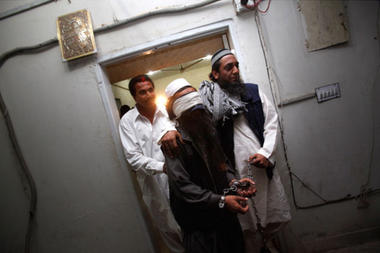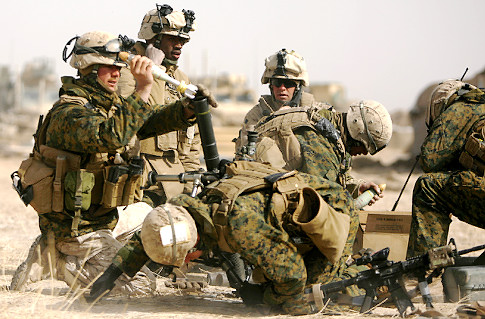MARJA, Afghanistan — As American Marines and Afghan soldiers have fought their way into this Taliban stronghold, the performance of the Afghan troops has tested a core premise of the American military effort here: in the not-too-distant future, the security of this country can be turned over to indigenous forces created at the cost of American money and blood.
Scenes from this corner of the battlefield, observed over eight days by two New York Times journalists, suggest that the day when the Afghan Army will be well led and able to perform complex operations independently, rather than merely assist American missions, remains far off.
The effort to train the Afghan Army has long been troubled, with soldiers and officers repeatedly falling short. And yet after nearly a decade of American and European mentorship and many billions of dollars of American taxpayer investment, American and Afghan officials have portrayed the Afghan Army as the force out front in this important offensive against the Taliban.
Statements from Kabul have said the Afghan military is planning the missions and leading both the fight and the effort to engage with Afghan civilians caught between the Taliban and the newly arrived troops.
But that assertion conflicts with what is visible in the field. In every engagement between the Taliban and one front-line American Marine unit, the operation has been led in almost every significant sense by American officers and troops. They organized the forces for battle, transported them in American vehicles and helicopters from Western-run bases into Taliban-held ground, and have been the primary fighting force each day.
The Afghan National Army, or A.N.A., has participated. At the squad level it has been a source of effective, if modestly skilled, manpower. Its soldiers have shown courage and a willingness to fight. Afghan soldiers have also proved, as they have for years, to be more proficient than Americans at searching Afghan homes and identifying potential Taliban members — two tasks difficult for outsiders to perform.
By all other important measures, though — from transporting troops, directing them in battle and coordinating fire support to arranging modern communications, logistics, aviation and medical support — the mission in Marja has been a Marine operation conducted in the presence of fledgling Afghan Army units, whose officers and soldiers follow behind the Americans and do what they are told.
That fact raises questions about President Obama’s declared goal of beginning to withdraw American forces in July 2011 and turning over security to the Afghan military and the even more troubled police forces.
There have been ample examples in the offensive of weak Afghan leadership and poor discipline to boot.
In northern Marja, a platoon of Afghan soldiers landed with a reinforced Marine rifle company, Company K, Third Battalion, Sixth Marines, which was inserted by American Army helicopters. The Marine officers and noncommissioned officers here quickly developed a mixed impression of the Afghan platoon, whose soldiers were distributed through their ranks.
After several days, no Marine officer had seen an Afghan use a map or plan a complicated patrol. In another indicator of marginal military readiness, the Afghan platoon had no weapons heavier than a machine gun or a rocket-propelled grenade.
Afghan officers organized no indirect fire support whatsoever in the week of fighting. All supporting fire for Company K — airstrikes, rockets, artillery and mortars — was coordinated by Marines. The Afghans also relied entirely on the American military for battlefield resupply.
Moreover, in multiple firefights in which Times journalists were present, many Afghan soldiers did not aim — they pointed their American-issued M-16 rifles in the rough direction of the incoming small-arms fire and pulled their triggers without putting rifle sights to their eyes. Their rifle muzzles were often elevated several degrees high.
Shouts from the Marines were common. “What you shooting at, Hoss?” one yelled during a long battle on the second day, as an Afghan pulled the trigger repeatedly and nonchalantly at nothing that was visible to anyone else.
Not all of their performance was this poor.
Sgt. Joseph G. Harms, a squad leader in the company’s Third Platoon, spent a week on the western limit of the company’s area, his unit alone with what he described as a competent Afghan contingent. In the immediacy of fighting side by side with Afghans, and often tested by Taliban fighters, he found his Afghan colleagues committed and brave.
“They are a lot better than the Iraqis,” said the sergeant, who served a combat tour in Iraq. “They understand all of our formations, they understand how to move. They know how to flank and they can recognize the bad guys a lot better than we can.”
Capt. Joshua P. Biggers, the Company K commander, said that the Afghan soldiers “could be a force multiplier.”
But both Marines suggested that the Afghan deficiencies were in the leadership ranks. “They haven’t had a chance yet to step out on their own,” Sergeant Harms said. “So they’re still following us.”
Shortfalls in the Afghan junior officer corps were starkly visible at times. On the third day of fighting, when Company K was short of water and food, the company command group walked to the eastern limit of its operations area to supervise two Marine platoons as they seized a bridge, and to arrange fire support. The group was ambushed twice en route, coming under small-arms fire from Taliban fighters hiding on the far side of a canal.
After the bridge was seized, Captain Biggers prepared his group for the walk back. Helicopters had dropped food and water near the bridge. He ordered his Marines and the Afghans to fill their packs with it and carry it to another platoon to the west that was nearly out of supplies.
The Marines loaded up. They would walk across the danger area again, this time laden with all the water and food they could carry. Captain Biggers asked the Afghan platoon commander, Capt. Amanullah, to have his men pack their share. He refused, though his own soldiers to the west were out of food, too.
Captain Biggers told the interpreter to put his position in more clear terms. “Tell him that if he doesn’t carry water and chow, he and his soldiers can’t have any of ours,” he said, his voice rising.
Captain Amanullah at last directed one or two of his soldiers to carry a sleeve of bottled water or a carton of rations — a small concession. The next day, the Afghan soldiers to the west complained that they had no more food and were hungry.
It was not the first time that Captain Amanullah’s sense of entitlement, and indifference toward his troops’ well-being, had manifested itself. The day before the helicopter assault, at Camp Leatherneck, the largest Marine base in Helmand Province, a Marine offered a can of Red Bull energy drink to an Afghan soldier in exchange for one of the patches on the soldier’s uniform.
Captain Amanullah, reclining on his cot, saw the deal struck. After the Afghan soldier had taken possession of his Red Bull, the captain ordered him to hand him the can. The captain opened it and took a long drink, then gave what was left to his lieutenant and sergeants, who each had a sip. The last sergeant handed the empty can back to the soldier, and ordered him to throw it away.
Whether they understand formations or not, if this unit is indicative of the state of the ANA we will be in Afghanistan for a very long time – decades, not years. They suffer from the same problems we have noted in Concerning the Importance of NCOs (citing From Why Arabs Lose Wars, Norvell B. De Atkine), with entitlement mentalities and very flat organizations that don’t recognize the value of NCOs. The strength of the U.S. military is, quite literally, the NCOs and enlisted men.
C.J. should keep up the good reporting and watch his six.





